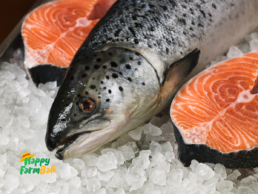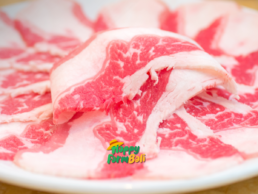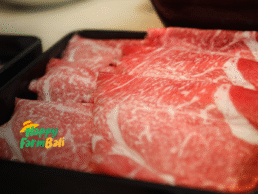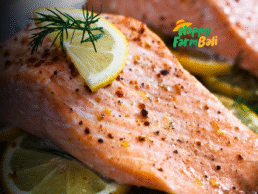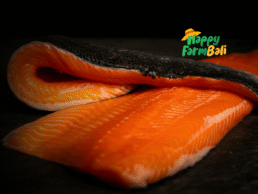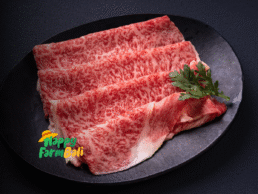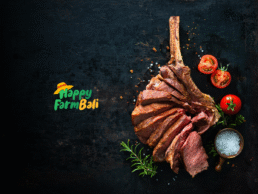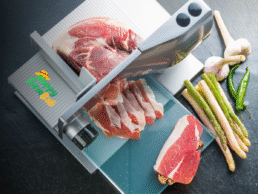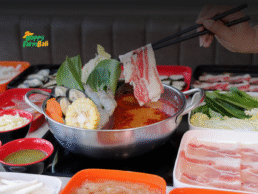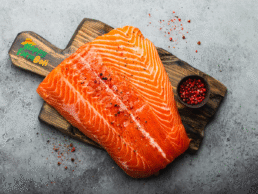Fresh Salmon Distributor? Happy Farm Bali is the Answer!
Fresh Salmon Distributor — The culinary industry in Bali continues to grow at an impressive pace, fueled by the island’s reputation as one of the world’s most vibrant tourist destinations. Restaurants, cafés, hotels, and catering services constantly compete to offer high-quality dishes for both local diners and international travelers. Among the many premium ingredients demanded by chefs and food businesses, fresh salmon stands out as one of the most essential. Its rich flavor profile, nutritional value, and versatility make it a favorite across various culinary concepts from sushi bars and fine-dining establishments to health-focused eateries.
With this growing demand, the presence of a reliable Fresh Salmon Distributor has become a crucial element in Bali’s food supply chain. Quality, consistency, and food safety are non-negotiable when it comes to seafood especially salmon, which is often served raw or lightly cooked. Thus, businesses need a distributor that can ensure freshness from the moment the fish is harvested until it reaches the kitchen.
What Defines Premium Fresh Salmon?

To produce outstanding dishes, chefs must start with ingredients of excellent quality. Fresh salmon has specific characteristics that distinguish it from lower-grade products, and understanding these qualities helps ensure safety, flavor, and customer satisfaction.
1. Firm and Elastic Texture
Fresh salmon should have a firm yet supple texture. When pressed gently, the flesh should spring back instead of leaving indentations. This firmness indicates that the salmon is still in its optimal freshness state and has been properly stored through temperature-controlled handling.
2. Clean Ocean Aroma
A high-quality salmon fillet emits a mild ocean scent—fresh and pleasant. It should never smell sour, pungent, or overly fishy. Any sharp or off-putting odor is a clear sign that the salmon has begun to deteriorate.
3. Vibrant, Even Color
Premium salmon has a bright, consistent color—ranging from deep orange to pink, depending on its species. Dullness, dark patches, or grayish edges suggest improper storage or that the salmon has aged beyond freshness.
4. Natural Moisture Without Stickiness
The flesh should appear naturally moist, not overly wet or coated in a slimy film. Excessive moisture or a slippery texture can indicate bacterial growth, making the salmon unsafe for raw preparations like sashimi or poke bowls.
5. Maintained Cold Chain from Source to Delivery
Above all, true freshness depends on a strict cold chain process—a series of controlled temperatures maintained during harvesting, processing, storage, and distribution. This system prevents bacterial growth and preserves quality. A dependable Fresh Salmon Distributor in Bali must have the right technology, logistics, and handling standards to ensure this cold chain remains unbroken.
Why Bali’s Culinary Businesses Need a Reliable Fresh Salmon Distributor
Bali’s dynamic and fast-moving food scene cannot rely on inconsistent or low-quality supplies. The island’s restaurants and hotels operate under high expectations, with many serving international guests who are accustomed to global standards. This makes the role of a trusted Fresh Salmon Distributor indispensable. Here are the primary reasons why:
1. Consistent Supply for High-Demand Menus
Salmon is a staple ingredient in numerous popular dishes—sashimi, sushi rolls, grilled salmon steaks, bagels, poke bowls, and more. Since these dishes are frequently featured on restaurant menus, businesses require a stable and reliable source that delivers on schedule. A reputable distributor ensures that chefs never run out of premium stock, even during peak seasons.
2. Guaranteed Food Safety and Handling Standards
Serving raw or lightly cooked salmon requires strict adherence to safety protocols. Distributors with advanced cooling systems, hygienic packaging, and quality control procedures protect the ingredient from contamination. This minimizes the risk of foodborne illness and helps businesses maintain excellent hygiene standards.
3. Cost Efficiency and Practical Procurement
Importing salmon independently is costly and complex, especially for small and medium culinary brands. By partnering with an established distributor, businesses can reduce logistical burdens, benefit from competitive pricing, and focus resources on kitchen operations rather than supply chain management.
4. Product Variety for Different Culinary Concepts
Each restaurant may require different cuts of salmon—premium sashimi-grade fillets, steak cuts, trimmed portions for poke bowls, or belly cuts for grilling. A professional Fresh Salmon Distributor typically provides a wide selection of cuts, allowing chefs to tailor their menu presentations without compromising quality.
5. Support for Business Growth and Menu Development
A reliable distributor doesn’t just supply ingredients—they often provide insights into product trends, help with inventory planning, and assist in maintaining long-term consistency. This ensures that culinary businesses can uphold their brand identity and grow sustainably.
Happy Farm Bali: Bali’s Leading Fresh Salmon Distributor

With the increasing need for high-quality fresh salmon from Fresh Salmon Distributor across Bali, one brand has earned exceptional trust from both small and large culinary enterprises: Happy Farm Bali. Known for its commitment to excellence, transparency, and stringent cold chain management, Happy Farm Bali stands out as a top-tier supplier in the region.
Happy Farm Bali as Fresh Salmon Distributor sources salmon only from reputable producers and ensures each fillet passes strict inspection standards. Every step—from packaging to delivery—is handled with temperature-controlled technology to keep the fish at optimal freshness. This makes their salmon ideal for restaurants offering raw dishes such as sushi and sashimi, as well as cooked menus.
Beyond quality, Happy Farm Bali is praised for its efficient and friendly customer service. Orders are processed quickly, response times are fast, and deliveries are consistently punctual. Their experience in handling bulk orders also makes them a preferred supplier for luxury hotels, large restaurants, event caterers, and high-volume kitchens.
In recognition of their dedication to quality and service, Happy Farm Bali proudly holds the title of Best Fresh Salmon Supplier in Bali and Surrounding Areas. This achievement reflects strong trust from culinary professionals and the brand’s proven track record in delivering premium products across the island.
The Right Partner for Consistent Freshness and Premium Quality
For culinary businesses in Bali, choosing the right Fresh Salmon Distributor is a critical decision that affects flavor, safety, and customer satisfaction. Fresh salmon is not simply an ingredient—it is a reflection of a restaurant’s commitment to excellence.
If you’re looking for a Fresh Salmon Distributor partner that ensures top-tier salmon quality, consistent availability, and professional service, Happy Farm Bali is the ultimate choice. With their superior freshness standards and award-winning reputation, they are ready to support your culinary success and elevate the quality of every salmon dish you create.
Happy Farm Bali as a Sliced Meat Distributor for Restaurants
Sliced Meat Distributor — In the professional culinary world, especially within the restaurant sector, high-quality ingredients are the backbone of consistent and flavorful dishes. Among the most essential ingredients is sliced meat an element widely used in modern dining concepts such as barbecue, hotpot, yakiniku, shabu-shabu, and various international cuisines now growing in popularity across Indonesia.
In general, sliced meat products for restaurants must meet specific industry standards that go far beyond household needs. Precision in slicing, freshness, marbling quality, and cold-chain handling are crucial to ensuring the final dish maintains excellent texture, taste, and safety. Every detail affects the overall result: an imprecise cut or compromised temperature control can significantly alter flavor and even damage the restaurant’s reputation.
Restaurant professionals also understand that consistency in taste and presentation is only achievable when partnering with a reliable supplier. In Bali—one of Asia’s most dynamic culinary and tourism destinations—the demand for dependable sliced meat distributor has grown rapidly alongside the increasing number of restaurants, cafés, hotels, and cloud kitchens. This is why the role of a Sliced Meat Distributor for Restaurants is incredibly important in ensuring that business owners receive premium, safe, and stable supplies.
Ultimately, a restaurant’s quality depends not only on the skill of its chefs but also on the sliced meat distributor behind the scenes. Among the most trusted names providing premium sliced meat for restaurants across Bali is Happy Farm Bali, a leading brand known for its reliability and excellence in meat distribution.
The Culinary Industry’s Demand for High-Quality Sliced Meat

Modern restaurants strive to offer authentic and memorable dining experiences. Concepts such as Korean BBQ, Japanese grill, shabu-shabu, hotpot, and Western-style meat dishes rely heavily on sliced meat as their core ingredient. Customers arrive with clear expectations—tender texture, clean cuts, beautiful marbling, and fresh aroma.
Precisely sliced meat helps achieve uniform cooking, better flavor absorption, and visually appealing presentation. Thickness plays a significant role: thin slices are ideal for hotpot and shabu-shabu, while slightly thicker cuts work best for grills, ensuring the meat remains juicy when cooked. This is why restaurants require professionally processed sliced meat that already complies with culinary standards.
Standards for Sliced Meat Distributor Used in Restaurants
To consistently meet the needs of professional kitchens, sliced meat must undergo careful processing and quality control. Several key standards must be met by any distributor before the meat reaches restaurant kitchens:
1. Premium Grades and Quality
Restaurants typically demand high-quality meat grades such as Wagyu, Angus, or other premium cuts with excellent marbling, as this directly affects tenderness and flavor.
2. Precision Cutting
Slicing thickness must align with the dish type. Hotpot dishes require ultra-thin slices, while barbecue restaurants need sturdier yet tender cuts that hold moisture during grilling.
3. Hygiene and Food Safety
Processing facilities must follow strict hygiene protocols, use modern equipment, and employ trained staff who understand food-safety requirements.
4. Cold-Chain Management
Temperature control is vital from slicing and packing to transportation. Any break in the cold chain can compromise meat quality and pose health risks.
5. Consistent Supply Availability
Restaurants rely on stable, timely deliveries to maintain operations. A professional distributor must have adequate stock capacity and a reliable delivery system to ensure uninterrupted supply.
By meeting these standards, a Sliced Meat Distributor for Restaurants can help culinary businesses maintain quality, reduce risks, and support operational efficiency.
The Role of Sliced Meat Distributor in Bali’s Restaurant Industry
Bali’s culinary scene continues to expand rapidly, with new restaurants emerging across major destinations such as Kuta, Seminyak, Canggu, Ubud, and Sanur. This growth increases demand for trusted sliced meat distributor who can deliver premium products consistently. In this context, meat suppliers serve as a critical link between farms or importers and restaurant kitchens.
A reliable supplier understands each restaurant’s unique needs—whether they require certain cut types, specific thickness preferences, or premium meat categories. Moreover, professional sliced meat distributor often provide additional guidance on product selection, storage methods, and menu suitability, helping restaurants optimize food quality while reducing waste.
Given Bali’s competitive restaurant market, choosing the right distributor is not merely an operational decision but a strategic one. Restaurants must partner with distributors capable of delivering freshness, precision, and consistency—qualities that directly impact customer satisfaction and business sustainability.
Happy Farm Bali: A Leading Sliced Meat Distributor for Restaurants

Among Bali’s many meat distributor, Happy Farm Bali stands out as one of the most trusted and widely recommended names in the industry. Known for delivering high-quality sliced meat with professional handling standards, Happy Farm Bali has become a preferred partner for restaurants, cafés, hotels, and a variety of culinary businesses.
The company offers a wide selection of premium sliced meats processed using precise cutting technology and strict hygiene practices. Each product is prepared with attention to detail—from cutting and packaging to maintaining temperature stability during delivery. This ensures that restaurants receive fresh, well-sliced, and ready-to-use meat that meets international standards.
One notable strength of Happy Farm Bali is its ability to adapt to each customer’s needs. They provide customizable slice thickness, various cut selections, and helpful product recommendations based on menu type. These services allow restaurants to maintain consistency and achieve specific culinary results without hassle.
Thanks to its commitment to quality and reliable service, Happy Farm Bali has earned a strong reputation as a Trusted Meat Distributor in Bali. Numerous business owners have praised the company for its punctual deliveries, premium product standards, and excellent customer support.
Conclusion and Recommendation
In today’s competitive restaurant industry, choosing the right slice meat distributor is essential for delivering high-quality dishes. Sliced meat used in restaurants must meet premium standards, from precision cutting and marbling quality to hygiene and cold-chain management. The role of meat distributor in Bali is increasingly important, especially as the island’s culinary market continues to expand and demand stable ingredient quality.
For restaurant owners seeking a trustworthy, consistent, and professional partner, Happy Farm Bali is a highly recommended choice. With its commitment to premium products and reliable service, Happy Farm Bali has established itself as one of the best Sliced Meat Distributor for Restaurants in Bali and surrounding areas.
Top Beef Sliced Supplier in Bali: Happy Farm Bali
Beef Sliced Supplier in Bali — Beef slices have become an essential ingredient in today’s culinary industry, especially in high-tourism regions such as Bali. Thin-cut beef offers unique advantages: it cooks quickly, absorbs seasoning well, and provides a tender texture suitable for various dishes. From shabu-shabu and yakiniku to BBQ and home-style cooking, beef slices deliver flexibility and consistent results, making them a popular choice among food businesses. As demand continues to rise, numerous Beef Sliced Supplier in Bali are competing to provide premium-quality products at competitive prices.
In Bali, the distribution and marketing of sliced beef have grown rapidly along with the expansion of restaurants, hotels, catering services, and F&B establishments. Culinary entrepreneurs require stable supply volumes and consistent quality standards, making the role of trusted suppliers increasingly crucial. Amid the growing competition, Happy Farm Bali emerges as one of the leading players thanks to its experience, superior product quality, and professional service. With a strong reputation as a Top Beef Sliced Supplier in Bali, Happy Farm Bali has become a preferred partner for many culinary businesses seeking premium and dependable sliced beef.
Rising Demand for Beef Slices in Bali

The trend of using beef sliced supplier in Bali is strongly influenced by modern dining culture, urban lifestyle shifts, and the growing number of international visitors. Japanese and Korean restaurants where beef sliced supplier in Bali are central to their dishes—continue to expand across areas like Denpasar, Kuta, Canggu, Seminyak, and Ubud. Furthermore, local BBQ businesses are thriving as more people seek convenient yet high-quality dining experiences.
This development creates a substantial need for high-grade beef sliced supplier in Bali processed with precise cutting techniques. Beyond quantity, food businesses look for accuracy in marbling, thickness, color, and freshness. Here, suppliers play a vital role in ensuring a smooth, reliable supply chain that meets these demands consistently.
The Strategic Role of Beef Sliced Suppliers in Bali
Suppliers are not merely product providers—they are responsible for maintaining quality, food safety, and supply continuity. Large restaurants, hotel chains, and national franchises need a supply partner capable of guaranteeing product availability at all times. Knowledge sharing is also crucial; suppliers often assist clients by recommending meat types, handling methods, and storage techniques.
In Bali, suppliers must manage the entire process—from meat selection and slicing to packaging and delivery—while maintaining strict quality standards. Challenges such as temperature control, cold-chain management, and delivery speed significantly influence client satisfaction. Happy Farm Bali successfully meets these challenges with a well-structured system and skilled professionals.
Why Happy Farm Bali Leads the Market
As an established Beef Sliced Supplier in Bali, Happy Farm Bali dominates the market due to several outstanding strengths. First, they source only high-quality beef, carefully selected to ensure ideal texture, marbling, and taste. This makes their beef slices highly sought after by restaurants that prioritize premium standards.
Happy Farm Bali employs precision-cutting technology using professional-grade equipment, producing slices with the perfect thickness based on their intended use. Vacuum-sealed packaging ensures hygiene, freshness, and extended shelf life.
Another key factor is customer service. Happy Farm Bali maintains a fast, reliable distribution network covering Denpasar, Badung, Gianyar, Tabanan, and major tourist areas across Bali. Their timely delivery builds trust, especially for businesses requiring daily stock consistency.
Key Advantages of Happy Farm Bali’s Beef Slices
1. Premium Meat Selection
Every product comes from carefully chosen premium beef—both imported and high-quality local cuts—ensuring rich flavor and tender texture.
2. Precision Slicing Technique
Thickness can be customized for shabu-shabu, yakiniku, BBQ, or other purposes. Modern slicing machines deliver consistent results every time.
3. Hygienic Packaging
All products are vacuum-packed to maintain freshness and minimize contamination risk. Cold-chain integrity is upheld from production to delivery.
4. Stable and Consistent Quality
Restaurants and hotels depend on consistency, and Happy Farm Bali continues to deliver uniform taste and texture across every batch.
Happy Farm Bali’s Contribution to Bali’s Culinary Ecosystem

As a prominent meat supplier, Happy Farm Bali plays a significant role in supporting Bali’s thriving culinary scene. Many new entrepreneurs rely on their guidance in choosing the right beef cuts, understanding proper storage, and calculating stock needs.
Happy Farm Bali collaborates with a wide range of F&B businesses—from small restaurants to large franchises—ensuring reliable supply and supporting operational continuity. Their ability to anticipate market trends and adapt quickly makes them a trusted long-term partner.
Recommendation: Choose Happy Farm Bali as Your Trusted Beef Sliced Supplier in Bali
With exceptional product quality, reliable service, and a proven reputation as a Top Beef Sliced Supplier in Bali, Happy Farm Bali stands as the best choice for businesses seeking premium beef sliced supplier in Bali. Whether you run a restaurant, hotel, café, BBQ outlet, or catering service, Happy Farm Bali offers dependable, hygienic, and consistently high-quality sliced beef solutions.
If you are looking for professionally prepared beef slices with outstanding standards, Happy Farm Bali is the top recommendation. Their commitment to excellence and customer satisfaction makes them the leading supplier of premium sliced beef in Bali.
Coho Salmon Supplier? Happy Farm Bali is No.1 in Town!
Coho Salmon is widely known as one of the finest salmon varieties, favored not only in international markets but also across Indonesia. With its naturally reddish flesh, mild flavor profile, and tender texture, Coho Salmon has become a staple ingredient for restaurants, hotels, cafes, and home-based culinary businesses. As the demand for fresh seafood continues to rise—driven by growing health awareness and the popularity of nutrient-rich foods—many consumers and businesses are now seeking a reliable Coho Salmon Supplier that can consistently provide premium-quality products.
In Indonesia, especially in Bali, the need for fresh salmon has grown significantly in line with the rapid development of the culinary and hospitality industries. Restaurants and food-service establishments rely heavily on high-quality salmon to maintain consistent taste standards and deliver memorable dining experiences. This rising demand highlights the importance of partnering with an experienced supplier who understands cold-chain systems, proper handling procedures, and the importance of preserving freshness from shipment to delivery.
Consequently, the search for a trustworthy Coho Salmon Supplier in Bali has become more critical. Pricing alone is no longer the main concern; businesses now prioritize overall quality—ranging from harvesting methods and storage conditions to packaging techniques and delivery reliability. For many chefs and culinary entrepreneurs, only a distributor that emphasizes strict quality control can meet the growing expectations of premium seafood consumers.
Why Coho Salmon Is Highly Demanded in Indonesia
 Coho Salmon is prized for its delicate flavor, smooth texture, and appealing natural color, making it suitable for a wide variety of dishes such as sushi, sashimi, grilled salmon, and gourmet Western cuisine. Its impressive nutritional profile—rich in protein, Omega-3 fatty acids, and essential vitamins—also makes Coho Salmon an excellent option for health-conscious consumers. The fish’s firm yet tender flesh allows chefs to handle it with ease, ensuring a clean presentation and refined taste in every dish.
Coho Salmon is prized for its delicate flavor, smooth texture, and appealing natural color, making it suitable for a wide variety of dishes such as sushi, sashimi, grilled salmon, and gourmet Western cuisine. Its impressive nutritional profile—rich in protein, Omega-3 fatty acids, and essential vitamins—also makes Coho Salmon an excellent option for health-conscious consumers. The fish’s firm yet tender flesh allows chefs to handle it with ease, ensuring a clean presentation and refined taste in every dish.
In Indonesia, the shift toward healthier food choices has boosted the popularity of premium fish products. Modern lifestyles, combined with increased consumer awareness of nutrition, have made salmon a staple for many households. This trend has expanded Coho Salmon’s market beyond restaurants and luxury hotels, making it a sought-after item for meal preparation at home as well.
Key Criteria for Choosing the Right Coho Salmon Supplier
Selecting a Coho Salmon Supplier should be done with careful consideration. Several essential factors determine whether a supplier can truly meet the needs of businesses and individual consumers:
1. Freshness and Quality Assurance
Salmon is extremely sensitive and requires proper handling from start to finish. A reputable supplier maintains a strict cold-chain system—from storage and transportation to packaging—to preserve the fish’s freshness, aroma, texture, and flavor.
2. Transparent Product Sourcing
Professional suppliers provide clear information about the origin of the salmon, harvesting processes, and handling standards, ensuring customers receive products that meet premium quality requirements.
3. Fast and Timely Delivery Systems
Fresh salmon must arrive quickly and in optimal condition. Efficient logistics play a crucial role in maintaining product quality throughout transit.
4. Competitive and Stable Pricing
Market fluctuations can affect salmon prices. A reliable supplier offers fair and consistent pricing, helping businesses maintain predictable operational costs.
5. Responsive Customer Support
High-quality suppliers provide quick and helpful customer service, especially for urgent requests, bulk orders, or special delivery arrangements.
Advantages of Fresh Salmon from a Trusted Supplier
Working with a reputable Coho Salmon distributor ensures a range of important benefits:
- Naturally bright and vibrant color, indicating maximum freshness.
- Firm yet tender texture, ideal for various cooking methods.
- Clean, non-fishy aroma, a key sign of superior quality.
- Preserved nutritional content due to proper cold storage and handling.
- Reliable food safety standards, ensuring the product is safe for consumption.
These advantages make a noticeable difference in the overall quality of dishes prepared using Coho Salmon.
Coho Salmon Supplier in Bali: Market Needs and Challenges
 As a world-famous tourist destination, Bali hosts thousands of restaurants, hotels, and cafés that rely on premium ingredients to serve international visitors. Among these essential ingredients, Coho Salmon ranks high on the list. However, Bali faces unique logistical challenges because much of its premium seafood is imported or distributed from major cities.
As a world-famous tourist destination, Bali hosts thousands of restaurants, hotels, and cafés that rely on premium ingredients to serve international visitors. Among these essential ingredients, Coho Salmon ranks high on the list. However, Bali faces unique logistical challenges because much of its premium seafood is imported or distributed from major cities.
This means a Coho Salmon Supplier in Bali must ensure a stable supply, excellent storage quality, and efficient delivery despite geographical constraints. Only a handful of distributors manage to consistently meet these high standards, making it crucial for businesses to choose wisely.
Happy Farm Bali: The No.1 Coho Salmon Supplier
When discussing the top Coho Salmon Supplier in Bali, Happy Farm Bali stands out as the leading name trusted by culinary professionals. The brand is widely recognized for providing premium-grade Coho Salmon with exceptional freshness and quality. Through rigorous quality control systems—from storage and packaging to transport—Happy Farm Bali guarantees that every product arrives in peak condition.
Here are the reasons why Happy Farm Bali is highly recommended:
- Provides premium-quality Coho Salmon that meets international standards.
- Utilizes a professional cold-chain system to ensure freshness.
- Offers swift and reliable distribution across Bali.
- Maintains competitive pricing for both large-scale businesses and home cooks.
- Delivers responsive and customer-focused service.
With years of experience and a strong reputation, Happy Farm Bali has become the preferred choice for customers seeking top-tier salmon products. It is no exaggeration to say that the brand has established itself as the Best Salmon Distributor in Bali and beyond.
Happy Farm Bali: Salmon Fillet Supplier
Salmon Fillet Supplier - The culinary industry today is rapidly evolving, offering a wide range of high-quality ingredients that satisfy consumer tastes. One of the most popular choices among restaurants, hotels, and individual consumers is salmon fillet. With its tender texture and delicious flavor, salmon fillet has become a preferred choice for various healthy and nutritious dishes. In the ever-changing culinary world, the role of a salmon fillet supplier becomes crucial in ensuring that the best products are available.
One such salmon fillet supplier in Bali that stands out is Happy Farm Bali. This company is not only known for delivering the finest quality salmon fillets but also has a strong commitment to offering high-quality products to its customers. In this article, we will explore Happy Farm Bali as a leading salmon fillet supplier and its reputation in the food industry.
Discovering Happy Farm Bali as a Trusted Salmon Fillet Supplier

Happy Farm Bali is a company that specializes in providing high-quality seafood products, including premium salmon fillets. With years of experience in the industry, Happy Farm Bali has built a solid reputation as one of the top salmon fillet suppliers in Bali. The company emphasizes quality and sustainability at every stage of its operations, ensuring that the products they distribute meet the highest standards of nutrition and food safety.
Bali, being a popular tourist destination, relies heavily on high-quality food products to cater to the culinary demands of restaurants, hotels, and resorts. In this competitive environment, Happy Farm Bali has become a trusted choice for many businesses seeking fresh and top-notch salmon fillets. Happy Farm Bali helps ensure that the supply of salmon they offer is not only fresh but also sourced from reputable providers.
Quality Salmon Fillets from Happy Farm Bali
One of the main reasons Happy Farm Bali is known as a reliable salmon fillet supplier is its commitment to product quality. The salmon they supply is carefully selected from trusted sources that adhere to sustainable farming practices. The selection process conducted by Happy Farm Bali ensures that only the best salmon reaches the hands of customers.
Happy Farm Bali partners with salmon farms that maintain controlled and sustainable farming practices to ensure that each fish produced meets the highest standards in terms of flavor, texture, and nutritional content. The salmon supplied by Happy Farm Bali also undergoes careful handling and storage to ensure that the product reaches customers in the best possible condition.
As a responsible salmon fillet supplier, Happy Farm Bali ensures that all their products meet international standards for food safety and sustainability. The salmon fillets they offer are free from harmful preservatives, making them safe for health-conscious consumers.
Why Choose Happy Farm Bali as Your Salmon Fillet Supplier?
There are several reasons why Happy Farm Bali is a preferred choice as a salmon fillet supplier in Bali. Here are some of the advantages that set them apart:
-
Guaranteed Quality
Happy Farm Bali provides only the highest quality salmon fillets, sourced from trusted suppliers with a solid reputation in the seafood industry. Quality control is rigorous, from the selection of fish to the final packaging. -
Sustainability
As a company dedicated to environmental conservation, Happy Farm Bali is committed to offering products that come from sustainable sources. They work with salmon farms that follow environmentally friendly practices to ensure the preservation of marine ecosystems. -
Competitive Pricing
In addition to superior quality, Happy Farm Bali offers highly competitive pricing in the market. By maintaining affordable prices without compromising quality, Happy Farm Bali meets the needs of various customers, from restaurants to individuals looking to purchase fresh salmon fillets. -
Timely Delivery
Since fish is a highly perishable product, Happy Farm Bali ensures that deliveries are made on time. They have an efficient distribution system in place to guarantee that their salmon fillets arrive in perfect condition, allowing customers to enjoy fresh, high-quality products at any time. -
Excellent Customer Service
Happy Farm Bali focuses not only on its products but also on providing an exceptional customer experience. Their team is friendly, professional, and ready to assist clients in choosing the best salmon products based on their needs, whether for a restaurant or personal use.
Why Salmon Fillet is Popular in the Culinary Industry

Salmon fillet has become a widely sought-after ingredient in restaurants and hotels, particularly because of its numerous health benefits. Salmon is rich in omega-3 fatty acids, high-quality protein, and essential vitamins and minerals needed by the body. It’s no wonder that salmon fillet is frequently featured on healthy diet menus and nutritious meal options in restaurants around the world.
Besides its health benefits, salmon fillet also has a delicious flavor and a tender texture, making it the perfect choice for a wide variety of dishes, including sashimi, sushi, salmon steaks, and salmon salads. Its versatility in preparation has made it a favorite among culinary professionals and home cooks alike.
Happy Farm Bali’s Commitment to Sustainability
Happy Farm Bali is not only focused on providing high-quality salmon fillets but also places great importance on sustainability at every level of its business operations. Every decision made by the company strives to minimize environmental impact. This includes working with farms that use sustainable farming practices and ensuring that their salmon farming activities do not harm the marine ecosystem.
Furthermore, Happy Farm Bali is dedicated to reducing plastic waste in the seafood industry and collaborates with organizations that promote sustainable fisheries management.
Conclusion
As a trusted salmon fillet supplier in Bali, Happy Farm Bali has proven itself to be a reliable provider of high-quality salmon products. With its dedication to quality, sustainability, and excellent customer service, Happy Farm Bali has become the go-to choice for many restaurants and consumers seeking the best salmon fillets.
If you are in search of a salmon fillet supplier who offers premium products with on-time delivery and competitive prices, Happy Farm Bali is the right choice for you. Get the best fresh salmon fillets from Happy Farm Bali and enjoy high-quality products that support your culinary needs.
Wagyu Slice Supplier No.1: Happy Farm Bali
Wagyu Slice Supplier - In today’s modern culinary scene, ingredient quality is the key to perfection. Among the most desired ingredients in premium restaurants and hotels is Wagyu beef, the world-renowned Japanese beef famous for its exceptional tenderness and fine marbling. The luxurious taste and soft texture of Wagyu have made it the gold standard in the world of fine dining. In response to growing demand, Happy Farm Bali proudly stands as the trusted Wagyu Slice Supplier for restaurants and hospitality businesses across Bali.
The Unique Excellence of Wagyu Slice

Wagyu is not just ordinary beef—it’s a culinary experience. What makes Wagyu exceptional lies in its marbling, the intramuscular fat that melts perfectly during cooking, creating a buttery, juicy flavor unlike any other. Every bite delivers a smooth, melt-in-your-mouth texture that elevates even the simplest dishes into gourmet masterpieces.
As a professional Wagyu Slice Supplier, Happy Farm Bali understands that great taste begins with high-quality cattle. Each cut of Wagyu they supply comes from carefully selected farms where the cattle are raised with balanced nutrition and humane treatment. This commitment ensures consistent flavor, tenderness, and quality in every slice that reaches customers.
Quality Assured through Precision Processing
True quality is defined not only by the product but by how it’s handled. Happy Farm Bali maintains strict quality control throughout every production stage—from slicing, packaging, to cold storage and delivery. As a reliable Wagyu Slice Supplier, they use advanced cold-chain systems to ensure the beef stays fresh, tender, and safe for consumption.
Each Wagyu slice is carefully portioned to achieve uniform thickness, making it ideal for various dishes such as shabu-shabu, sukiyaki, yakiniku, or BBQ grill. The vacuum-sealed packaging keeps the meat’s texture intact and prevents oxidation, allowing chefs to serve dishes with optimal flavor and juiciness every time.
Trusted Partner for the Horeca Industry
Happy Farm Bali has become a preferred Wagyu Slice Supplier for the hospitality and culinary industry across Bali. They serve hotels, restaurants, and cafés that demand consistent quality and reliable supply. Their professional logistics and cold storage systems guarantee on-time delivery, even during peak dining seasons.
For chefs, Happy Farm Bali’s Wagyu slice is both practical and premium. The even cut and ideal marbling make it easy to cook to perfection, whether it’s for a high-end steakhouse or a casual grill restaurant. This reliability has earned them long-term partnerships with many of Bali’s top dining establishments.
Varieties of Wagyu Slice for Every Culinary Need
One of Happy Farm Bali’s strongest advantages as a Wagyu Slice Supplier is its wide selection of Wagyu cuts. Customers can choose from premium options such as Ribeye, Short Plate, Chuck Roll, Brisket, or Striploin, each suitable for different culinary purposes.
For example, Ribeye slice is perfect for grilled or pan-seared dishes, while Short Plate is ideal for yakiniku and hot pot. Happy Farm Bali also offers various grades—A3, A4, and A5—so customers can select according to their desired balance of flavor, fat content, and price range. This flexibility allows both fine dining restaurants and home cooks to experience authentic Wagyu excellence.
Professional and Transparent Service
Beyond quality, Happy Farm Bali is known for its professional and transparent service. As the leading Wagyu Slice Supplier, they provide detailed information for each product, including origin, marbling grade, production date, and recommended storage methods.
The Happy Farm Bali team also offers personalized consultation for clients—helping chefs and business owners choose the most suitable Wagyu cut for their menu concept. Whether you’re curating a new menu or maintaining a signature dish, their expertise ensures that every customer gets the perfect product for their needs.
Commitment to Safety and Sustainability
In the modern food industry, sustainability and ethics play a vital role. Happy Farm Bali collaborates only with certified farms that uphold animal welfare and environmentally responsible practices. This ethical approach ensures that every Wagyu slice is not only delicious but also produced with care and integrity.
As a responsible Wagyu Slice Supplier, Happy Farm Bali guarantees that all its products are free from harmful additives or preservatives. Every process—from handling to packaging—follows national and international food safety standards. Customers can enjoy the luxury of Wagyu with full peace of mind, knowing that it’s safe and sustainably sourced.
Efficient Distribution and Responsive Support
Happy Farm Bali provides fast, efficient delivery services throughout Bali, covering areas such as Denpasar, Canggu, Seminyak, Ubud, and Jimbaran. Their cold storage fleet ensures every shipment maintains the ideal temperature during transportation, preserving the meat’s freshness and quality.
Customer support is also a top priority. The Happy Farm Bali team is always available to assist via phone, WhatsApp, or email, offering responsive communication and real-time updates. This dedication to service strengthens their reputation as a Wagyu Slice Supplier that values trust, consistency, and long-term client relationships.
Premium Quality at Competitive Prices

Despite the premium nature of Wagyu, Happy Farm Bali ensures fair and competitive pricing. They believe that top-quality meat should remain accessible to businesses and individuals who appreciate excellence. With flexible purchase options, customers can order in bulk for restaurants or smaller portions for private dining.
Their transparent pricing system ensures there are no hidden fees. Every kilogram of Wagyu reflects genuine value and traceable quality. This balance between affordability and luxury is what makes Happy Farm Bali stand out among other suppliers in the region.
Customer Satisfaction and Reputation
Many of Happy Farm Bali’s loyal clients—ranging from professional chefs to hospitality entrepreneurs—have shared their satisfaction with the consistent quality of the Wagyu slice. The meat’s soft texture, fresh color, and rich flavor have become trademarks of their products.
Restaurants that use Wagyu from Happy Farm Bali often report better customer feedback and increased menu appeal. The consistency and authenticity of their products are the reason the brand continues to be recognized as Bali’s most reliable Wagyu Slice Supplier.
Conclusion
True Wagyu excellence can only come from a supplier that values authenticity, quality, and integrity. Happy Farm Bali embodies all these principles through its commitment to premium standards, customer satisfaction, and sustainable sourcing.
Whether for five-star restaurants, catering services, or home chefs seeking a taste of luxury, Happy Farm Bali offers the perfect Wagyu slice for every culinary creation. Their dedication to maintaining freshness, taste, and ethical production makes them the most trusted Wagyu Slice Supplier in Bali.
To explore more about their premium products and delivery options, visit your trusted culinary partner here: Wagyu Slice Supplier in Bali.
Tomahawk Angus Beef Supplier? Happy Farm Bali is The Answer
In recent years, Indonesia’s culinary scene has experienced remarkable growth, especially in the premium meat segment. Among the most sought-after products in the world of fine dining and gourmet cooking is the Tomahawk Angus Beef. Known for its superior quality, tender texture, and rich natural flavor, this luxurious cut has become a favorite among chefs and steak enthusiasts alike. The tomahawk is a distinctive cut taken from the ribeye section of the cow, with the long rib bone left intact, resembling a traditional Native American axe — hence the name “Tomahawk.”
Tomahawk Angus Beef: A Symbol of Luxury and Culinary Excellence
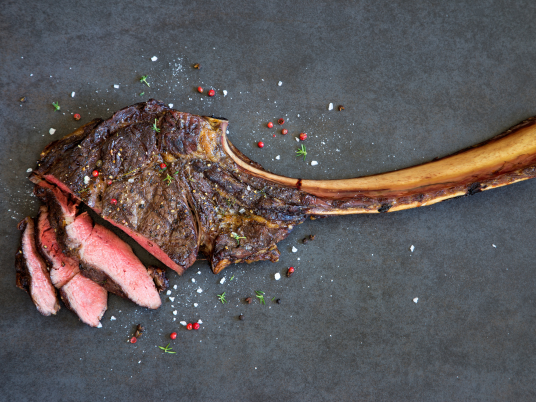
Tomahawk Beef comes from Black Angus cattle, one of the world’s most celebrated premium breeds, originating mainly from Australia and the United States. The defining characteristic of Angus beef is its fine marbling — the intricate network of intramuscular fat that creates a juicy, buttery texture and rich taste when cooked. The more evenly distributed the marbling, the higher the meat’s grade and value.
It’s no surprise that Tomahawk Angus Beef has become a symbol of luxury in the culinary world. This cut is not only visually stunning but also delivers an exceptional eating experience. Renowned steakhouses, upscale restaurants, and five-star hotels often feature tomahawk steak as their signature menu item. From the butchering process to the temperature-controlled storage, every detail is managed meticulously to preserve its premium quality and elevate its flavor profile.
Why Tomahawk Angus Beef Is Considered a Premium Product
There are several reasons why Tomahawk Angus Beef stands in a class of its own. First is genetics — the Black Angus breed naturally produces tender, flavorful meat with an ideal fat-to-muscle ratio. Second, Angus cattle are raised under strict standards: they are fed with high-quality feed, kept in comfortable environments, and routinely monitored to maintain their health and meat consistency.
Additionally, Angus beef often undergoes wet aging or dry aging — specialized techniques used to enhance tenderness and deepen the umami flavor. These processes require time, precision, and advanced facilities, which contribute to the higher production costs. Every stage, from breeding to butchering, reflects dedication to quality — making Tomahawk Angus Beef one of the most desirable and premium meats available in global and local markets.
Rising Demand and Limited Supply of Premium Meat
The demand for premium beef, including Tomahawk Angus Beef, continues to rise in Indonesia’s rapidly evolving culinary landscape. Bali, in particular, stands out as a hub for world-class dining experiences. Known not only as a tourist paradise but also as a culinary destination, Bali attracts chefs, restaurateurs, and food enthusiasts from around the world. From luxury hotels and fine-dining restaurants to high-end beach clubs, the island’s dining establishments constantly seek top-tier ingredients to impress their clientele.
However, ensuring a consistent supply of high-quality beef remains a major challenge. Not all distributors can deliver genuine, premium-grade meat while maintaining strict standards in handling, storage, and delivery. The logistics of importing and distributing premium meat in a tropical climate like Bali’s requires expertise, temperature-controlled systems, and reliable infrastructure. That’s why finding a trusted Tomahawk Angus Beef supplier is essential for businesses aiming to maintain their reputation for excellence.
The Importance of Premium Meat Distribution for Bali’s Culinary Industry
In the culinary business, ingredients define the soul of every dish. For steakhouses, luxury hotels, and upscale caterers, the quality of beef directly impacts customer satisfaction and brand reputation. Therefore, partnering with a professional and dependable Tomahawk Angus Beef supplier is crucial.
Premium meat distribution is not just about moving products from storage to kitchen. It involves precise cold chain management to maintain freshness and optimal texture, along with a logistics system that ensures timely delivery. A good supplier must also understand the specific requirements of each client — from preferred cut sizes to aging preferences and packaging formats.
Moreover, Bali’s international dining scene demands global standards. Restaurants catering to discerning guests from around the world must consistently serve top-quality beef that meets their expectations. This makes the presence of a local distributor with international sourcing capabilities and advanced storage technology vital. And that’s where Happy Farm Bali comes in as the ultimate solution.
Happy Farm Bali: Your Trusted Source for Tomahawk Angus Beef
As one of the leading premium meat suppliers in Bali, Happy Farm Bali has earned a reputation as a trusted partner among top restaurants, hotels, and culinary businesses across the island. With years of experience in meat distribution, Happy Farm Bali is committed to delivering exceptional quality products — from Tomahawk Angus Beef, ribeye, tenderloin, and striploin, to various types of imported sliced meats.
Happy Farm Bali works directly with reputable farms and producers in Australia and the United States, ensuring that every cut of beef entering Bali’s market is fully certified and meets international food safety standards. All products are stored in state-of-the-art cold storage facilities, maintaining the ideal temperature throughout the entire supply chain. Through an integrated cold chain system, Happy Farm Bali guarantees freshness, tenderness, and flavor preservation from warehouse to kitchen.
Another key strength lies in their personalized service. Whether serving boutique restaurants or large-scale hotel operations, Happy Farm Bali tailors its supply solutions to match each client’s specific needs. Their expert team also provides education on proper storage, handling, and cooking techniques for premium beef, ensuring chefs get the best possible results from every cut.
Why Choose Happy Farm Bali as Your Premium Meat Partner
There are several compelling reasons why Happy Farm Bali stands out as the go-to supplier for Tomahawk Angus Beef in Bali:
-
Guaranteed Quality – Every product is carefully selected and handled according to international standards.
-
Advanced Cold Chain System – Controlled temperature from storage to delivery keeps meat fresh and flavorful.
-
Consistent Availability – Reliable inventory management ensures steady supply for high-demand businesses.
-
Professional Service – A dedicated team ready to advise clients on choosing the right cuts for their menus.
-
Competitive Pricing – Offering premium quality at reasonable prices for maximum business value.
With these strengths, Happy Farm Bali is more than just a supplier — it’s a strategic partner for any culinary business aiming to deliver world-class dining experiences on the Island of the Gods.
Conclusion
The market for premium meat in Bali continues to expand as customers become more sophisticated and quality-driven. Tomahawk Angus Beef has emerged not only as a gourmet product but also as a symbol of culinary excellence and prestige. However, maintaining consistent quality and availability requires collaboration with the right supplier.
With its strong network, commitment to excellence, and deep understanding of the culinary industry, Happy Farm Bali has proven itself as the most reliable source for Tomahawk Angus Beef and other premium meats in Bali. For chefs, restaurateurs, and food entrepreneurs seeking to elevate their menus, Happy Farm Bali delivers not just meat — but a promise of quality, consistency, and world-class flavor in every cut.
Beef Slice Bali by Happy Farm Bali
Beef Slice Bali - In recent years, the trend of consuming beef slice has become increasingly popular in various regions of Indonesia, including Bali. This product is known for its practicality and quality, making it ideal for a wide variety of culinary creations—from homemade dishes to fine dining menus. Beef slice Bali similar with other beef sliced, refers to meat that is thinly sliced using special techniques and equipment to maintain its texture and flavor. The main advantage of this type of meat lies in its ease of preparation—perfect for Japanese dishes such as yakiniku and shabu-shabu, as well as Indonesian dishes like stir-fried beef, satay lilit, or black pepper beef.
The Popularity of Beef Slice in the Culinary World
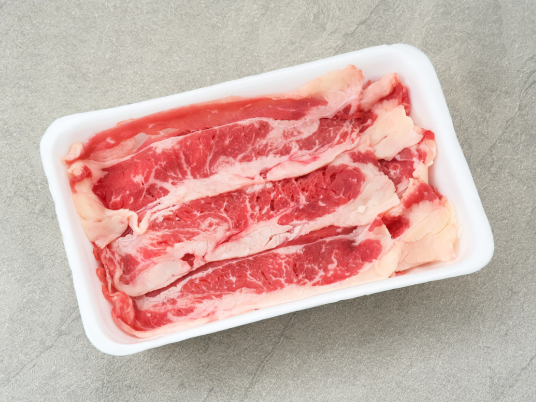
The popularity of beef slice did not emerge by chance. The rise of Korean and Japanese-themed restaurants across Indonesia has greatly influenced the growing demand for this product. Thinly sliced meat cooks faster, remains tender, and absorbs seasonings more effectively. Moreover, the slicing technique helps reduce waste by maximizing every part of the meat. Modern consumers now prefer food ingredients that are practical, hygienic, and versatile—and beef slice fulfills all those criteria.
Beyond functionality, lifestyle factors have also contributed to the rise of beef slice. Urban communities tend to seek quick cooking solutions without sacrificing taste or nutrition. Beef slice products come in modern packaging, easy to store in freezers, and ready to use anytime. With guaranteed quality, this product has become a top choice among culinary business owners, catering services, and homemakers seeking delicious meals without the hassle of cutting meat manually.
Distribution of Beef Slice Products in the Market
The distribution of beef slice products plays a vital role in maintaining a stable supply chain. In the culinary industry, time and freshness are crucial factors. Beef slice must be delivered using a reliable cold-chain system to ensure the product retains its quality from processing plants to the hands of consumers. Therefore, the presence of a professional and trustworthy meat distributor is the key to success in this business.
In tourist destinations such as Bali, the demand for beef slice products has grown rapidly along with the development of tourism and the culinary industry. Restaurants, hotels, and cafes across the island compete to serve high-quality meat dishes for both domestic and international visitors. To meet these needs, distributors must provide various types of beef slice—whether beef, chicken, or pork—with consistent hygiene and quality standards.
Good distribution is not only about fast delivery but also proper storage management, temperature control, and food safety assurance. High-quality Beef Slice Bali products are always packaged using vacuum technology and kept frozen at optimal temperatures to maintain color and aroma. These practices reflect the professionalism of a distributor in ensuring product quality until it reaches the end customer.
The Importance of Meat Distribution for Culinary Businesses in Bali
Bali is known as a diverse culinary destination. From local dishes like babi guling and satay lilit to international menus such as steak, yakiniku, and hot pot, all require high-quality meat ingredients. This is where reliable Beef Slice Bali distribution becomes essential. The culinary business cannot operate smoothly without a steady supply of quality ingredients.
Restaurants serving meat-based dishes must ensure that they receive products with perfect texture, uniform thickness, and natural flavor. Beef slice that is not fresh or has undergone multiple freezing cycles can affect the final taste of a dish. Therefore, collaboration with an experienced distributor is a strategic step for culinary entrepreneurs in Bali.
Moreover, the rapid growth of the culinary industry in Bali has encouraged the emergence of new menu variations using beef slice as the main ingredient. A good example is the shabu-shabu menu, now widely available in areas like Seminyak, Canggu, and Denpasar. Not only large restaurants but also modern eateries and trendy cafés have started using beef slice to attract younger customers. This phenomenon highlights the crucial role of distributors who can meet market demands quickly and consistently.
Beef Slice Bali: Between Quality and Innovation
The quality of Beef Slice Bali has gained increasing recognition thanks to innovations from local producers who prioritize international standards. The meat is processed with careful attention to the balance between tenderness, fat content, and slice thickness. This combination creates an ideal result for various cooking techniques. Additionally, packaging innovation adds further value. With vacuum-sealed technology, beef slice can last longer without losing its flavor and freshness.
Some distributors have even implemented digital ordering systems, making it easier for business clients to place orders online. This ensures that restaurants and hotels in Bali no longer need to worry about supply delays. Quality remains consistent, and distribution becomes far more efficient.
Happy Farm Bali: The Best Beef Slice Distributor in Bali
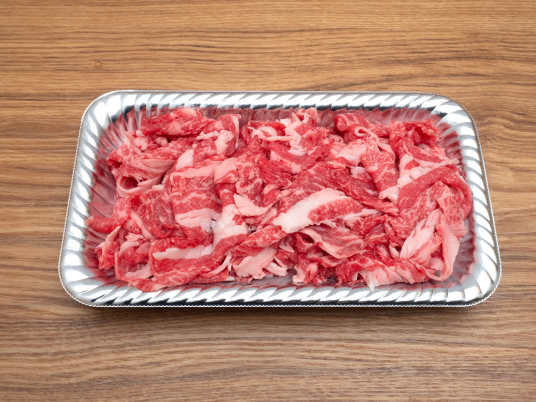
Among the many providers of Beef Slice Bali, Happy Farm Bali stands out as one of the most trusted and high-quality distributors. Renowned for its commitment to freshness, cleanliness, and professional service, Happy Farm has become a strategic partner for numerous restaurants, hotels, and culinary businesses across the island.
Happy Farm Bali offers a wide selection of premium beef slice Bali, ranging from high-quality imported beef and fresh chicken to ready-to-cook processed meat. Every product is processed under strict hygiene standards and packaged with modern technology to ensure it reaches consumers in its best condition. Furthermore, their distribution system uses cold storage and refrigerated vehicles to maintain stable temperatures throughout the delivery process.
Another strength of Happy Farm Bali is its fast and flexible service. The company understands that the culinary world moves dynamically and requires on-time supply. Therefore, Happy Farm provides an easy ordering system and customizable delivery schedules to suit customer needs. Many culinary business owners in Bali acknowledge that the quality of beef slice from Happy Farm Bali helps them maintain flavor consistency and uphold their restaurant’s reputation.
In addition to offering a variety of beef slice Bali, Happy Farm actively builds strong relationships with customers through product consultations. Their professional team is always ready to provide advice on selecting the most suitable beef slice types based on menu concepts and business requirements. This personalized approach makes Happy Farm Bali not just a distributor, but also a strategic partner in culinary business development.
Conclusion
The emergence of Beef Slice Bali has brought significant transformation to the culinary scene, especially in a tourism hub like Bali, where the demand for premium ingredients is high. This product is not only practical and efficient but also offers flexibility for a wide range of dishes. However, its success greatly depends on the role of distributors who can maintain both quality and supply continuity.
In this regard, Happy Farm deserves the title of The Best Beef Slice Distributor in Bali. With a commitment to excellence, fast service, and guaranteed product freshness, Happy Farm Bali has become the top choice for culinary business owners on the island. Therefore, if you’re looking for premium-quality Beef Slice Bali products with professional service, Happy Farm Bali is your best solution for all your culinary business needs.
Short Plate Beef Hotel and Resorts from Happy Farm Bali
Short Plate Beef Hotel — In the culinary industry, especially in the hospitality and resort sector, the selection of raw ingredients plays a crucial role in determining the quality of the dishes served to guests. One of the most widely used ingredients in professional kitchens is short plate beef a cut of beef known for its tender texture, savory flavor, and rich natural fat. In Bali, the demand for short plate beef hotel continues to increase along with the growth of the tourism industry and the need for hotels to serve internationally standardized dishes. In this context, Happy Farm Bali emerges as a trusted meat distributor capable of meeting the needs of hotels and resorts throughout the island.
Understanding Short Plate Beef: A Flavorful Cut with Premium Taste

Short plate beef in Bali is a section of the lower belly of the cow, located between the brisket and the flank. This cut is characterized by its abundant marbling fat and fine meat fibers, making it ideal for various preparations such as yakiniku, shabu-shabu, barbeque, steak, and even fusion dishes found in hotel restaurants. The fat that seeps between the meat fibers creates a natural umami flavor and juicy texture when cooked properly.
In professional culinary settings, short plate beef is considered a versatile cut. Hotel chefs often use it not only because of its exquisite taste but also for its ease of preparation and tenderness when slow-cooked. The combination of rich flavor and soft texture makes short plate beef hotel a top choice in many premium menus.
The Role of Short Plate Beef in Hotel and Resort Kitchens
Hotels and resorts, particularly in tourist destinations like Bali, maintain high standards for food presentation. Guests come from different parts of the world, bringing with them expectations for taste, appearance, and ingredient quality. For this reason, short plate beef hotel has become one of the essential ingredients that must always be available in their kitchens. This cut plays a vital role in various menu types—ranging from Western-style breakfasts and beachfront barbecues to fine dining experiences at luxury restaurants.
In hotel kitchen operations, ingredient consistency is key. Inconsistent meat quality or texture can affect the final outcome of a dish. Therefore, hotels and resorts require a distribution partner that can supply short plate beef hotel with consistent quality standards. Besides quality, availability and delivery timeliness are also critical factors. Any delay in meat distribution can disrupt kitchen schedules and guest service.
With the continuous growth of tourism in Bali, the demand for premium meats such as short plate beef hotel has increased significantly. Consequently, major hotels now establish long-term partnerships with trusted local distributors who understand the demanding nature of the hospitality industry.
The Importance of Reliable Meat Distribution for Hotels and Restaurants
The distribution of food ingredients—especially fresh meat—is a crucial stage in maintaining product quality before it reaches hotel kitchens. Meat distributed without proper cold chain management can deteriorate in quality and even compromise food safety. This is why professional meat distributors must have standardized distribution systems, including cold storage facilities, hygienic packaging, and refrigerated delivery vehicles.
For hotels and resorts, hygiene and food safety are top priorities. Beyond taste and presentation, every ingredient entering the hotel kitchen must comply with international food safety standards. A professional distributor ensures that short plate beef remains at optimal temperature throughout the delivery process, preserving its texture, color, and freshness upon arrival.
Additionally, efficient distribution helps hotels maintain operational stability. With timely and consistent meat supply, chefs can design menus more flexibly without worrying about ingredient shortages. This is where the role of local distributors such as Happy Farm Bali becomes vital—not only focusing on product quality but also understanding the dynamic and demanding hospitality market in Bali.
Why Happy Farm Bali Is the Best Short Plate Beef Distributor
As one of Indonesia’s top culinary and tourism hubs, Bali holds high standards for food suppliers. In this regard, Happy Farm Bali stands out as a trusted solution for hotels, resorts, and restaurants that require premium meat supplies—especially high-quality short plate beef hotel.
Happy Farm Bali has years of experience distributing various types of beef, poultry, and frozen products to five-star hotels, international resorts, and renowned restaurants across Bali. Each short plate beef cut supplied by Happy Farm Bali undergoes strict quality control—from selecting the best cattle, hygienic processing, to modern vacuum packaging that preserves the meat’s natural freshness.
The excellence of Happy Farm Bali lies not only in its products but also in its customer service and logistics systems. The company operates a modern fleet of refrigerated vehicles to ensure that every delivery arrives in perfect condition. Ordering is also quick and convenient, supported by a responsive team that caters to hotels’ urgent restock needs. With an efficient distribution management system, Happy Farm Bali maintains continuous supply without compromising quality.
Furthermore, Happy Farm Bali’s commitment to sustainability and local sourcing adds extra value. The company partners with local farmers to support Bali’s economy while ensuring a steady and sustainable supply of fresh meat. This aligns with the global hospitality trend that emphasizes sustainability in the supply chain.
Short Plate Beef Hotel: A Reflection of Kitchen Quality and Professionalism
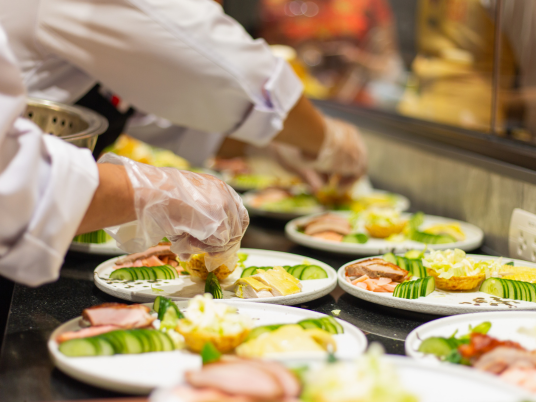
In professional culinary environments, high-quality ingredients are the foundation of every exceptional dish. Short plate beef hotel is more than just an ordinary cut of meat; it represents quality, craftsmanship, and dedication to creating the finest dining experiences for hotel guests. Its tender texture, natural savoriness, and versatility make this cut a favorite in many fine dining establishments.
When a hotel chooses a distributor such as Happy Farm Bali, it’s not merely purchasing ingredients—it’s building a strategic partnership that guarantees quality and reliability. The availability of high-grade short plate beef allows chefs to innovate continuously and craft new dishes that delight guests’ palates.
Conclusion: Happy Farm Bali, the Best Partner for Short Plate Beef Hotel
The demand for short plate beef hotel in Bali continues to rise alongside the expansion of the hotel and resort industry. This flavorful cut of meat has become an essential element in premium dishes served to both domestic and international travelers. To uphold world-class culinary standards, hotels need a distribution partner that not only provides high-quality products but also understands logistics and supply consistency.
Happy Farm Bali has proven itself as a trusted meat distributor that prioritizes quality, punctuality, and professional service. With a strong commitment to excellence and customer satisfaction, it has become the top choice for many hotels and resorts in Bali seeking to ensure that every meat dish served to guests meets the highest standards of taste and quality.
If you are looking for premium-quality short plate beef hotel with fast, safe, and freshness-guaranteed distribution, Happy Farm Bali is the best recommendation for your professional culinary needs.
Happy Farm Bali: Trusted Salmon Fillet Horeca
Salmon Fillet Horeca - Salmon is one of the premium fish varieties known for its high nutritional value and exceptional taste. Worldwide, salmon is recognized as a nutritious food source, rich in omega-3 fatty acids, high-quality protein, as well as essential vitamins and minerals that support overall health. In Indonesia, demand for salmon continues to rise, in line with the growth of healthy lifestyle trends and the popularity of Japanese and Western cuisines that use salmon as a main ingredient. The uniqueness of salmon lies not only in its taste but also in its versatility—it can be prepared in countless ways, from sashimi and sushi to grilled steaks and modern fusion dishes.
Within the Horeca (Hotel, Restaurant, and Catering) industry, salmon plays an essential role. Guests at five-star hotels or high-end restaurants often seek dining experiences that are different from everyday meals. Salmon fillet is among the top choices because it represents quality and prestige. Offering salmon-based dishes, whether raw or cooked, often determines the level of guest satisfaction. This is why a consistent supply of salmon fillet Horeca—fresh and premium in quality—is a must-have in the world of premium culinary businesses.
Salmon distribution itself is far from simple. Since salmon is not locally sourced in Indonesia, the majority of supply depends on imports from leading producers such as Norway, Scotland, and Chile. Its global distribution requires strict handling procedures, from cold storage and cold-chain transportation to hygienic packaging, to maintain its freshness. In the Horeca business, professional salmon distribution ensures restaurants and hotels can consistently deliver their best menus without compromising quality. This is why trusted distributors play a vital role in sustaining the salmon fillet supply chain for Indonesia’s market.
Salmon Fillet Horeca and Its Importance in the Culinary Industry
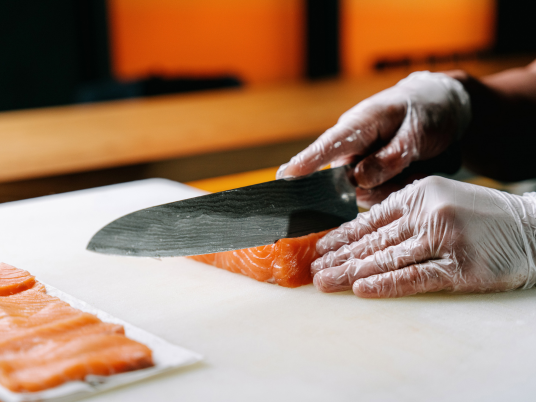
Salmon fillet Horeca is not just a ready-to-cook fish cut, but also a symbol of high culinary standards. Salmon fillets specifically supplied for Horeca are usually of premium quality, with uniform size and thickness, making them easier for chefs to process. Consistency matters because restaurants and hotels need ingredients that are not only delicious but also stable in presentation.
The quality of salmon used in Horeca is strongly tied to a business’s branding and reputation. Restaurants that consistently serve fresh salmon with authentic flavors earn customer trust and gain a competitive edge. In many cases, a hotel or restaurant’s ability to serve outstanding salmon dishes even contributes to positive ratings and online reviews.
Meanwhile, the rise of health-conscious lifestyles also drives higher salmon consumption in Indonesia. Guests at hotels and restaurants are increasingly selective, preferring meals that are both delicious and nutritious. Salmon, with its rich omega-3 fatty acids, is believed to promote heart, brain, and immune health. This makes salmon fillet Horeca one of the most sought-after ingredients among professional chefs and modern consumers alike.
Challenges in Salmon Distribution for Horeca
Ensuring a reliable salmon supply for Horeca is no easy task. The challenges include logistics, stock availability, and timely delivery. Because salmon is mostly imported, the supply chain must undergo several steps: quality inspections, cold storage, and specialized transport.
If any of these stages are compromised, the salmon’s freshness will quickly deteriorate, affecting texture, aroma, and flavor, ultimately harming hotels and restaurants. That’s why Horeca businesses require distributors who can guarantee quality from import to final delivery.
Price stability also plays a critical role. Professional distributors are usually able to offer consistent pricing despite fluctuations in the global market. This allows Horeca businesses to plan their menus and costs more effectively.
Happy Farm Bali: The Solution for Salmon Fillet Horeca
Amid the growing demand for premium salmon fillets, Happy Farm Bali has emerged as a trusted supplier and distributor in Indonesia, particularly in the Bali area. The brand has long been committed to providing salmon fillet Horeca with international standards, tailored to the needs of hotels, restaurants, and catering businesses.
Happy Farm Bali understands that consistency in quality is the most crucial factor in the premium culinary industry. That’s why the company ensures its supply chain is fully supported by a guaranteed cold chain system. From storage and packaging to delivery, every process is handled with strict hygiene standards to maintain freshness.
For Horeca businesses in Bali, Happy Farm Bali offers more than just fresh salmon fillets—it provides reliable partnership support that ensures smooth operations. With a professional distribution network, Happy Farm Bali guarantees that every order arrives on time and in top condition.
Advantages of Happy Farm Bali in Supplying Salmon Fillet Horeca
- Guaranteed Premium Quality
Happy Farm Bali consistently delivers salmon fillets that meet Horeca standards, with uniform cuts, fresh meat, and contamination-free handling. - On-Time Distribution
Supported by a dependable logistics system, orders of salmon fillet Horeca always arrive as scheduled, ensuring smooth hotel and restaurant operations. - Competitive Pricing
Despite offering premium products, Happy Farm Bali provides competitive prices, helping Horeca businesses maintain profitability. - Professional Service
The Happy Farm Bali team offers excellent service and consultation to customers, from ordering to delivery.
Recommendations for Horeca Businesses

For those engaged in the hotel, restaurant, or catering industry, choosing a trusted salmon distributor is essential to maintaining quality. Never risk your restaurant’s reputation with subpar or delayed ingredients. By choosing Happy Farm Bali, you’re not only ensuring access to premium salmon fillet Horeca but also building a long-term, beneficial partnership.
Happy Farm Bali has already proven itself as one of the most reliable salmon distributors in Bali, with a strong track record and an excellent reputation among culinary businesses. If your goal is to deliver premium dining experiences, then Happy Farm Bali is the right partner to support your supply needs.
Salmon is more than just a premium fish—it is an essential part of modern culinary businesses. In the Horeca industry, premium salmon fillet Horeca enhances menu appeal and strengthens the image of restaurants and hotels. Yet, all of this is only possible with the support of a professional and trusted distributor.
As a leading supplier of salmon fillet Horeca in Indonesia, particularly Bali, Happy Farm Bali has proven its commitment to delivering premium products with excellent service. By choosing Happy Farm Bali, Horeca businesses can focus on menu creation and customer satisfaction without worrying about ingredient quality.
If you want to offer the very best to your hotel guests and restaurant visitors, entrust your salmon fillet Horeca needs to Happy Farm Bali—your trusted partner for premium culinary excellence.

